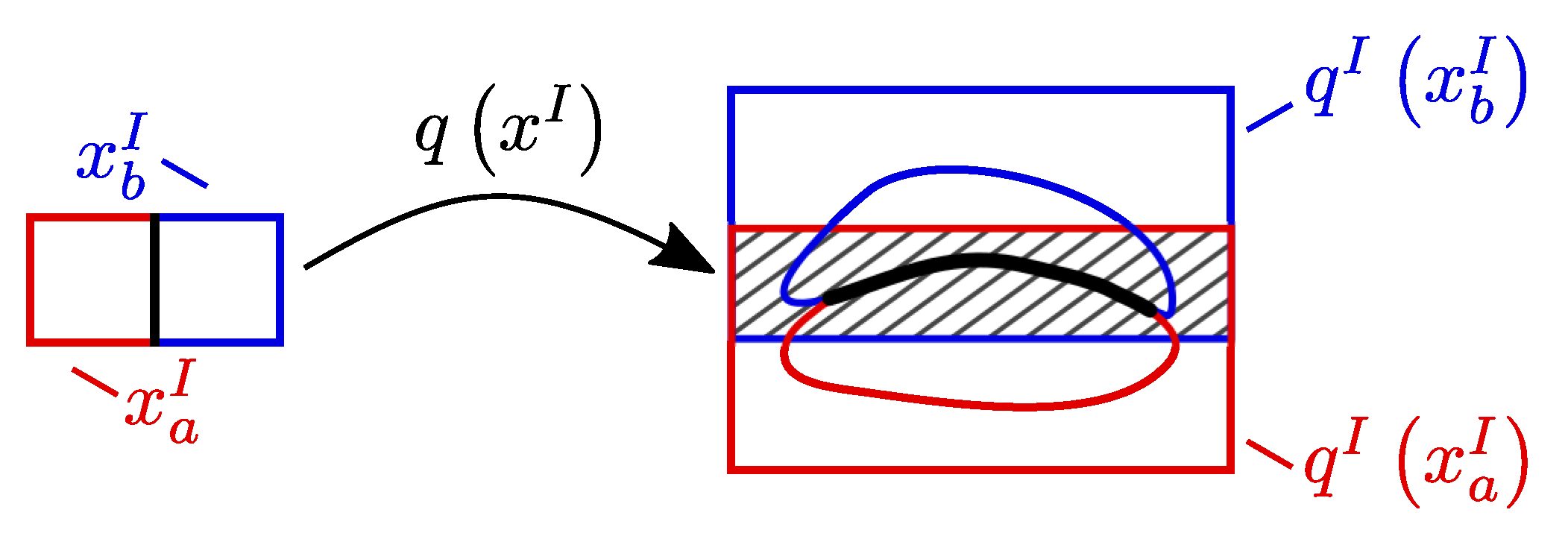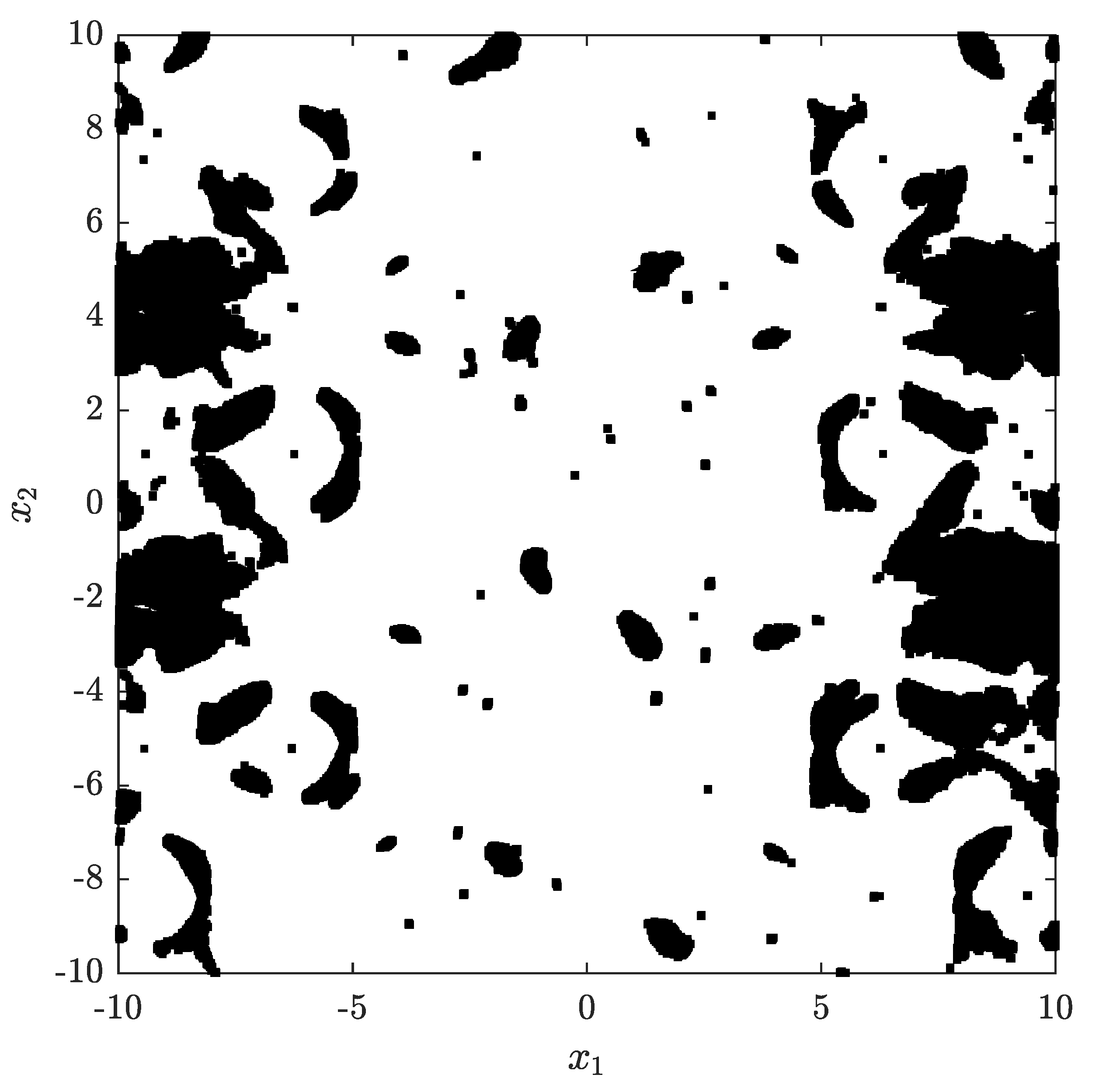Observability of Uncertain Nonlinear Systems Using Interval Analysis
Abstract
:1. Introduction
2. Materials and Methods
2.1. Interval Arithmetics
2.2. Observability of Uncertain Nonlinear Systems
2.3. Algorithm for Studying the Observability of Nonlinear Systems
| Algorithm1Robust observability |
| - INPUT: , , and |
|
2.3.1. Initialization of the Algorithm
2.3.2. Calculation of Lie Derivatives for Proving Distinguishability Using the Power Series
2.3.3. Example: Direct Calculation of Lie Derivatives
2.3.4. Applying the Local Condition
2.3.5. Final Remarks
3. Results of the Algorithm
3.1. Example 1
3.2. Example 2
3.3. Example 3
3.4. Remark to the Presented Examples
4. Discussion
Author Contributions
Funding
Conflicts of Interest
References
- Hermann, R.; Krener, A. Nonlinear controllability and observability. IEEE Trans. Autom. Control. 1977, 22, 728–740. [Google Scholar] [CrossRef] [Green Version]
- Ding, S.; Chen, W.; Mei, K.; Murray-Smith, D.J. Disturbance Observer Design for Nonlinear Systems Represented by Input–Output Models. IEEE Trans. Ind. Electron. 2020, 5, 1222–1232. [Google Scholar] [CrossRef] [Green Version]
- Fliess, M. A remark on nonlinear observability. IEEE Trans. Autom. Control. 1982, 27, 489–490. [Google Scholar] [CrossRef]
- Brockett, R.W. Nonlinear Systems and Nonlinear Estimation Theory. In Stochastic Systems: The Mathematics of Filtering and Identification and Applications. NATO Advanced Study Institutes Series (Series C—Mathematical and Physical Sciences); Springer: Dordrecht, The Netherlands, 1981; pp. 441–477. [Google Scholar]
- Tibken, B. Observability of nonlinear systems–An algebraic approach. In Proceedings of the 2004 43rd IEEE Conference on Decision and Control (CDC) (IEEE Cat. No. 04CH37601), Nassau, Bahamas, 14–17 December 2004; pp. 4824–4825. [Google Scholar]
- Kawano, Y.; Ohtsuka, T. Global observability of polynomial systems. In Proceedings of the SICE Annual Conference, Taipei, Taiwan, 18–21 August 2010; pp. 2038–2041. [Google Scholar]
- Zeng, S.; Allgöwer, F. On the ensemble observability problem for nonlinear systems. In Proceedings of the 2015 54th IEEE Conference on Decision and Control (CDC), Osaka, Japan, 15–18 December 2015; pp. 6318–6323. [Google Scholar]
- Zeng, S. On the Ensemble Observability of Dynamical Systems. Ph.D. Thesis, Institut für Systemtheorie und Regelungstechnik, University of Stuttgart, Stuttgart, Germany, 2016. [Google Scholar]
- Lagrange, S.; Delanoue, N.; Jaulin, L. Guaranteed Numerical Injectivity Test via Interval Analysis. In Trends in Constraint Programming; ISTE: London, UK, 2017; pp. 233–244. [Google Scholar]
- Lagrange, S.; Delanoue, N.; Jaulin, L. On sufficient conditions of the injectivity: Development of a numerical test algorithm via interval analysis. Reliable Comput. 2007, 13, 409–421. [Google Scholar] [CrossRef]
- Röbenack, K.; Reinschke, K.J. An efficient method to compute Lie derivatives and the observability matrix for nonlinear systems. In Proceedings of the International Symposium on Nonlinear Theory and Applications (NOLTA), Dresden, Germany, 17–21 September 2010; pp. 625–628. [Google Scholar]
- Rauh, A.; Minisini, J.; Hofer, E. Verification Techniques for Sensitivity Analysis and Design of Controllers for Nonlinear Dynamic Systems with Uncertainties. Int. J. Appl. Math. Comput. Sci. 2009, 19, 425–439. [Google Scholar] [CrossRef]
- Röbenack, K.; Voßwinkel, R. Formal Verification of Local and Global Observability of Polynomial Systems Using Quantifier Elimination. In Proceedings of the 2019 23rd International Conference on System Theory, Control and Computing (ICSTCC), Sinaia, Romania, 9–11 October 2019; pp. 314–319. [Google Scholar]
- Tarski, A. A Decision Method for Elementary Algebra and Geometry. In Quantifier Elimination and Cylindrical Algebraic Decomposition. (A Series of the Research Institute for Symbolic Computation, Johannes-Kepler-University, Linz, Austria); Springer: Vienna, Austria, 1998. [Google Scholar]
- Paradowski, T.; Tibken, B.; Swiatlak, R. An Approach to Determine Observability of Nonlinear Systems Using Interval Analysis. In Proceedings of the 2017 American Control Conference (ACC), Seattle, WA, USA, 24–26 May 2017; pp. 3932–3937. [Google Scholar]
- Paradowski, T. Intervallarithmetische Untersuchung der Beobachtbarkeit und Zustandsschätzung nichtlinearer Systeme. Ph.D. Thesis, Faculty of Electrical, Information and Media Engineering, University of Wuppertal, Wuppertal, Germany, 2020. Submitted. [Google Scholar]
- Moore, R.E.; Kearfott, R.B.; Cloud, M.J. Introduction to interval analysis. In Society for Industrial and Applied Mathematics; SIAM: 3600 University City Science Center Philadelphia, PA, USA, 2009. [Google Scholar]
- Jaulin, L.; Kieffer, M.; Didrit, O.; Walter, É. Applied Interval Analysis; Springer: London, UK, 2001. [Google Scholar]
- Röbenack, K. Nichtlineare Regelungssysteme; Springer: Vieweg, Germany, 2017. [Google Scholar]
- Frisk, E.; Krysander, M. Sensor placement for maximum faultisolability. In Proceedings of the 18th International Workshop on Principles of Diagnosis (DX-07), Nashville, TN, USA, 29–31 May 2007. [Google Scholar]
- Raissi, T.; Efimov, D.; Zolghadri, A. Interval State Estimation for a Class of Nonlinear Systems. IEEE Trans. Autom. Control. 2012, 57, 260–265. [Google Scholar] [CrossRef]
- Brönnimann, H.; Melquiond, G.; Pion, S. The design of the Boost interval arithmetic library. Theor. Comput. Sci. 2006, 351, 111–118. [Google Scholar] [CrossRef] [Green Version]
- The Boost C++ Libraries. Available online: http://www.boost.org/ (accessed on 24 January 2020).
- Eigen. Eigen C++ Librarie. Available online: http://eigen.tuxfamily.org/ (accessed on 24 January 2020).
- Rohn, J. Bounds on Eigenvalues of Interval Matrices. J. Appl. Math. Mech. 1998, 78, 1049–1050. [Google Scholar] [CrossRef] [Green Version]
- Smale, S. Mathematical Problems for the Next Century. The Math. Intell. 1998, 20, 7–15. [Google Scholar] [CrossRef]


© 2020 by the authors. Licensee MDPI, Basel, Switzerland. This article is an open access article distributed under the terms and conditions of the Creative Commons Attribution (CC BY) license (http://creativecommons.org/licenses/by/4.0/).
Share and Cite
Paradowski, T.; Lerch, S.; Damaszek, M.; Dehnert, R.; Tibken, B. Observability of Uncertain Nonlinear Systems Using Interval Analysis. Algorithms 2020, 13, 66. https://0-doi-org.brum.beds.ac.uk/10.3390/a13030066
Paradowski T, Lerch S, Damaszek M, Dehnert R, Tibken B. Observability of Uncertain Nonlinear Systems Using Interval Analysis. Algorithms. 2020; 13(3):66. https://0-doi-org.brum.beds.ac.uk/10.3390/a13030066
Chicago/Turabian StyleParadowski, Thomas, Sabine Lerch, Michelle Damaszek, Robert Dehnert, and Bernd Tibken. 2020. "Observability of Uncertain Nonlinear Systems Using Interval Analysis" Algorithms 13, no. 3: 66. https://0-doi-org.brum.beds.ac.uk/10.3390/a13030066





